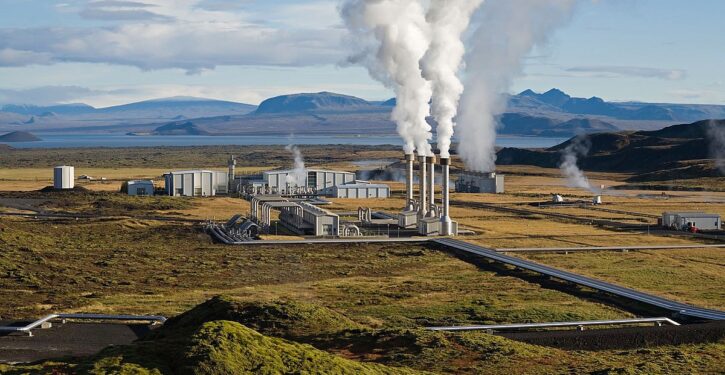
Geothermal energy may radically expand due to technological advances, just as oil and gas production in the U.S. rose to record levels after fracking techniques were perfected. The Economist reports:
George Mitchell, a scrappy independent oilman, is known as the father of fracking. Nearly three decades ago, he defied Big Oil and the conventional wisdom of his industry by making practical the hitherto uneconomic technique of pumping liquids and sands into the ground to force out gas and oil from shale rock and other tight geological formations. The enormous increase in productivity that resulted, known as the shale revolution, has transformed the global hydrocarbon business.
Now Fervo Energy, another scrappy Texan upstart, is applying such hydraulic fracturing—alongside other techniques borrowed from the petroleum industry—to the sleepy geothermal sector. Should it succeed, it would mean this relatively fringe source of energy could, in time, become a major player in the energy mix.
Geothermal energy typically taps underground heat by connecting to reservoirs of hot water or steam. But those reservoirs are found only in a few areas, which restricts the potential of conventional geothermal power. By contrast, “enhanced geothermal systems” (EGS), such as the one employed by Fervo, deploy hydraulic stimulation to create channels in hot rocks found across the globe. In 2023, Fervo conducted a successful pilot project in Nevada, and attracted Google as major customer. This June, Southern California Edison, a major utility, entered into a deal to purchase 320 megawatts of power from Fervo’s much larger new project in Utah, which seeks to use mass-manufacturing methods to use the technology it piloted on a vast scale. The deal is the biggest-ever purchase agreement for geothermal energy.
Two weeks ago, Fervo had more good news. In spite of needing to drill much deeper at its Utah site, it succeeded in doing so in a mere 21 days, reducing its drilling time by 70% compared to its Nevada site. Moreover, drilling cost fell: the fourth well it drilled cost only half as much as the first, due to learning through experience. Fervo is already producing more geothermal energy that the Energy Department set as a 2035 target for U.S. geothermal energy production. And as The Economist notes, “Hot rocks might also turn out to be surprisingly effective batteries. A paper published in January in Nature Energy, a journal, argues that EGS sites can be operated flexibly, with more water injected underground when needed to build up pressure and liquid released on demand to make power.” Potentially “over 100 gigawatts (GW) of geothermal power could be run at a profit in the American west, surpassing the output of the country’s entire nuclear” energy industry.
Right now, nuclear energy produces around 20% of the electricity generated in America. Nuclear energy produces no greenhouse gas emissions or air pollution. Nuclear plants generate most electric power in countries like France and Slovakia, but in the U.S., it has been much more difficult and costly to construct a nuclear power plant. The Nuclear Regulatory Commission makes it very expensive to construct a nuclear plant — even the application process is incredibly expensive and usually takes years of unnecessary delay. Even when nuclear plants are already operating safely and providing badly needed power, anti-nuclear activists sometimes get government officials to shut them down. Recently, however, the NRC approved the construction of a nuclear plant with an innovative design and a non-water cooled reactor.
A recent study found that nuclear power is better for the environment than wind energy, solar power, or fossil fuels. Yet green activists in places like Germany have still forced the closure of nuclear power plants, making Germany more reliant on coal for energy. And they have done so even though “every major study, including a recent one by the British medical journal Lancet, finds the same thing: nuclear is the safest way to make reliable electricity,” says a long-time environment activist. “Solar panels require 17 times more materials in the form of cement, glass, concrete, and steel than do nuclear plants, and create over 200 times more waste,” such as “dust from toxic heavy metals including lead, cadmium, and chromium.” Unlike wind farms, nuclear power plants don’t kill birds. And “wind turbines, surprisingly, kill more people than nuclear plants.” “Nuclear power is the safest form of energy we have, if you consider deaths per megawatt of energy produced,” notes Yale University professor Steven Novella.
Hopefully, geothermal energy can reduce the need for vast solar and wind farms that displace vegetation and kill birds. Solar energy subsidies caused the deforestation of thousands of acres of forest in Massachusetts, without providing a reliable power supply. t makes little sense to subsidize solar panels in Massachusetts, which is often cloudy or overcast, with thin blue or snowy gray puritan skies. Solar panels are more useful in sunnier states. Paige Lambermont, a research fellow with the Competitive Enterprise Institute, notes that “Solar power works when the sun is shining, and then quickly stops producing as soon as the sun goes down. As a result, it is unreliable and only provides electricity on an intermittent basis.”



